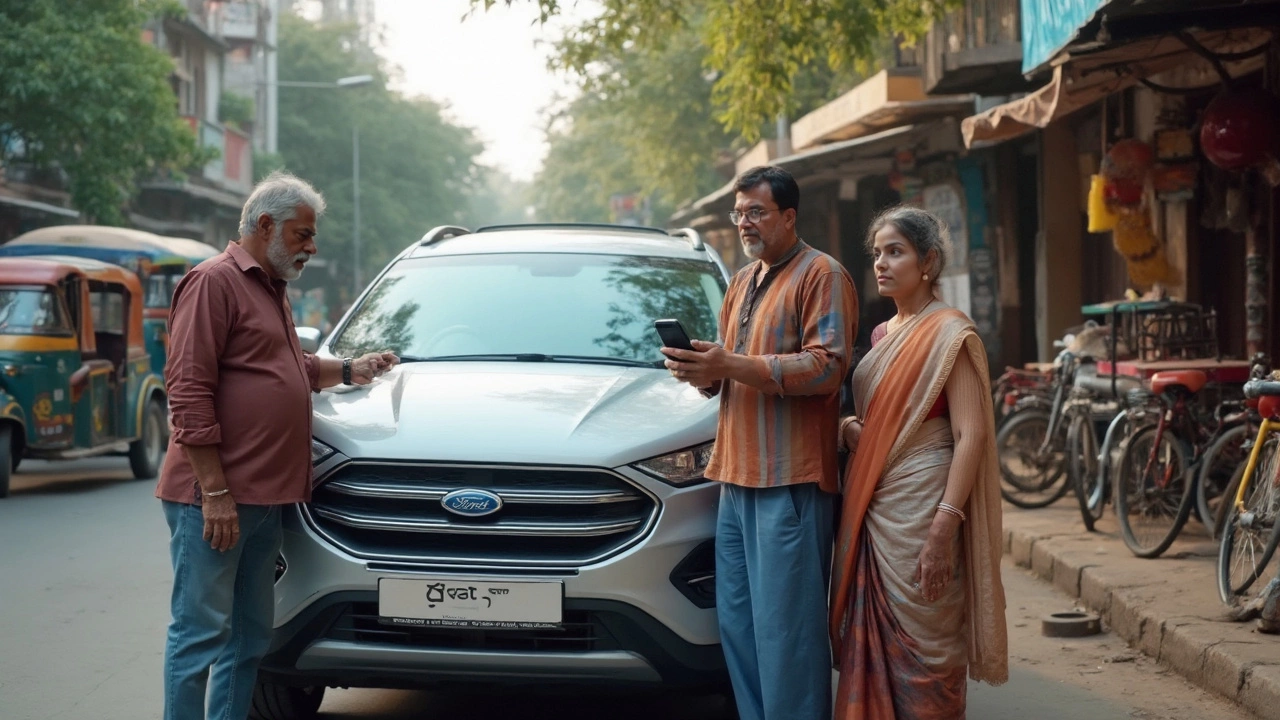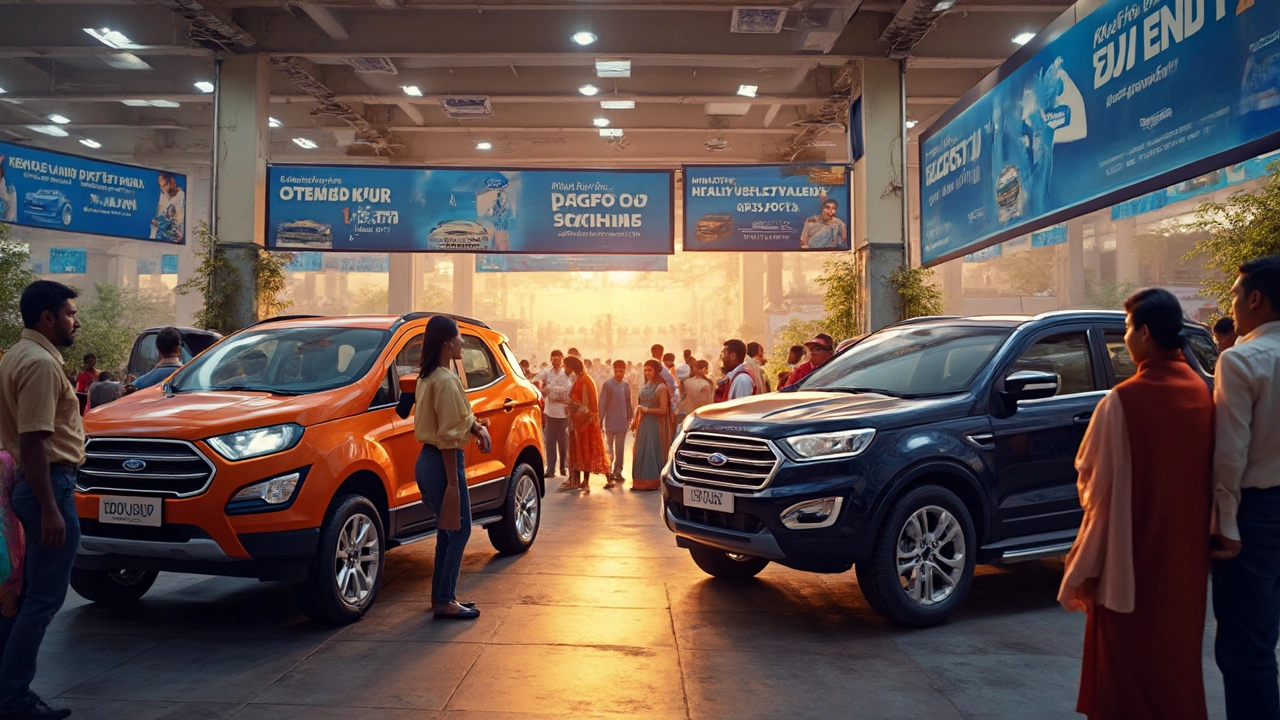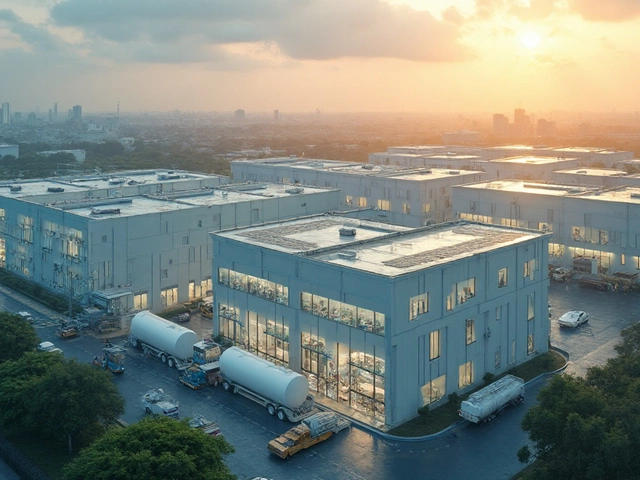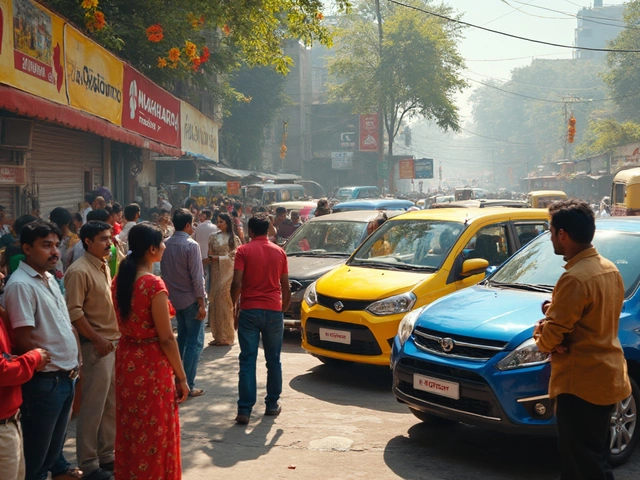You know how rumors fly—someone says Ford is leaving India for good, and next thing you know, messages start popping up in every WhatsApp group. People wonder if their car warranty is still valid or if spare parts will vanish like magic. But is Ford really pulling the plug, or is the truth much messier?
The big change actually happened way back in 2021, when Ford announced it would stop making and selling most cars in India. Since then, lots of car owners (including my cousin who loves his EcoSport) have scrambled to figure out what this means for daily life. In 2023, Ford even tried to come back with a menu of electric vehicles, but nothing stuck—probably because the market is packed with new brands and hybrids everyone wants to try.
Still, Ford isn’t totally gone. As of today, showrooms look half-empty, and new Fords are hard to spot. But their service centers are still open, parts are still moving, and yes, warranties are being honored. So, if you’re worried your Ford Fiesta will turn into an expensive paperweight, relax—there are real-world fixes and workarounds we’ll cover in this guide.
- Why Did Ford Shrink Its India Operations?
- What’s Changed for Ford Owners and Buyers?
- How Ford’s Exit Affects Service and Spare Parts
- The Real Story Behind Ford’s Indian Factories
- Tips If You Own or Want a Ford in India
Why Did Ford Shrink Its India Operations?
This story goes way beyond one bad year or a single flop model. Ford's exit from the Indian car scene was all about money problems and tough competition. For years, they just couldn't sell enough cars to cover the huge costs of running factories, paying workers, and sticking to global safety standards. Back in 2021, Ford officially announced they'd stop making cars like the EcoSport and Figo for Indian buyers. They called it a “sizable business loss”—and it wasn’t a small number. Between 2011 and 2021, Ford India lost over $2 billion.
Let’s take a closer look.
| Year | Ford India Annual Car Sales |
|---|---|
| 2017 | 87,580 |
| 2018 | 89,571 |
| 2019 | 75,977 |
| 2020 | 45,799 |
| 2021 | 24,805 |
See the drop? While homegrown brands like Maruti Suzuki and Tata Motors sold lakhs of cars each year, Ford’s numbers fell off a cliff. Indian buyers wanted affordable, fuel-efficient cars with low maintenance, but Ford’s lineup didn’t check enough of those boxes.
On top of that, the Indian car market turned cut-throat. New players like Kia and MG swooped in with trendy SUVs and better tech. Plus, the COVID-19 pandemic hit in 2020-21 and made it even harder for car companies to keep the lights on.
So, Ford chose to scale back: they stopped making new cars for Indian buyers, closed most big factories, and focused on importing some high-end models (like the Mustang) for people who could pay luxury prices. They didn’t totally leave—the service network stayed, and old owners weren’t just abandoned. But normal car sales pretty much dried up.
If you hear rumors about Ford quitting completely, remember—they shrunk operations because competing here just didn’t make sense anymore, especially against local and Asian brands dominating the Ford India story for decades.
What’s Changed for Ford Owners and Buyers?
If you own a Ford or were thinking of buying one, things are definitely different now. The biggest shift happened in 2021, when Ford said it would stop making cars for the regular Indian market. No new Aspire, Figo, or EcoSport rolling out of their Chennai and Sanand factories. Showrooms have shrunk, and you don’t see those big Ford launch ads anymore.
For existing Ford owners, the biggest worry was: What about service, warranty, and spare parts? Here’s the relief—Ford promised (and so far has delivered) continued support. Their authorized service centers didn’t close overnight and are still running, at least in most big cities. You can still book a service, get your regular oil change, or fix major issues. Ford’s website says they are committed to providing spare parts for up to ten years from the production stop, so parts aren’t disappearing just yet. That said, rare models and older cars might see longer wait times, especially for non-critical trims or imported parts.
If you were planning to buy, it’s tough to find new Ford cars, unless you grab old stock or demo units that some dealers still have left. Used Fords are still available—and here’s a tip: prices for models like the EcoSport or Endeavour have stayed more stable than expected, mostly because they’re seen as solid cars with affordable maintenance. New buyers should check the age of the car, the status of warranty, and whether their local service center is still open. If you travel or move a lot, you might notice some towns have shut their Ford outlets, which can make emergency repairs more tricky.
There’s also some good news: with Ford focusing more on exports and high-end models, the quality of after-sales service has stayed decent, since fewer customers now use the same centers. You just have to plan ahead when booking service or ordering spares—no more popping in last minute and hoping for instant repairs.
- Servicing and parts are still available, but book ahead and expect possible delays for rare parts.
- No new mass-market cars from Ford, so buying new is limited to remaining inventory or pre-owned options.
- Resale values have held steady for their popular models.
- Ford supports their warranties—always confirm with your dealer just in case something changes locally.
The bottom line? The Ford India story isn’t about a vanishing act, it’s about limited change—and a bit more planning for anyone holding onto their set of blue oval keys.

How Ford’s Exit Affects Service and Spare Parts
This is where things get real for anyone driving a Ford in India. When the company scaled back its operations, the biggest fear was simple: "Will I be able to keep my car running without massive hassles?" Here’s what’s actually going on as of mid-2025.
First, Ford promised to keep supporting its existing customers even after they stopped making cars here. Most service centers are still operating in major cities—Delhi, Mumbai, Chennai, and Bengaluru, to name a few. Smaller towns have fewer options, but you’re not left high and dry. Owners are still able to book service appointments and get the usual maintenance jobs done. Check out the data from Ford's official reports below:
| Year | Active Service Centers | Major Cities Covered | Average Wait Time (Days) |
|---|---|---|---|
| 2021 | 530 | 120 | 3 |
| 2023 | 430 | 85 | 4 |
| 2025 | 355 | 64 | 5 |
You’ll notice there are fewer centers now than before. But Ford says all warranties for existing vehicles will still be honored, and service for all models still being provided up to 2027, at least. That’s written in their customer Q&As and has held up so far, according to feedback from Ford owner groups and personal experience.
Now, spare parts are always the next big headache. Right after the announcement, prices for some parts shot up. By 2023, supply started to even out as Ford struck deals with third-party suppliers. The company also started importing certain key components directly for popular models like EcoSport, Endeavour, and Figo. Genuine parts for common fixes—brake pads, filters, lights—are still available at most outlets. If your car needs something rare, it might take a week or two to arrive, but it’s rarely a total dead end.
Here are a few tips for dealing with service and parts if you own a Ford now:
- Always call the service center ahead of time—don’t just show up expecting instant work.
- Ask about the availability and costs of parts before you book that big repair.
- If your Ford is out of warranty, check trusted third-party garages that work with genuine Ford parts. Ask around in owner forums or local groups for the best names.
- Keep an eye on recalls or service bulletins from Ford’s official website—they’re still posting updates for Indian customers.
The big Ford India story: your support network is leaner, but it hasn’t disappeared. Staying organized and a bit proactive means your Ford can keep running for years. It’s smart to keep your car’s paperwork and service records in order, just in case you need help with warranty claims or whenever you decide to sell.
The Real Story Behind Ford’s Indian Factories
Let’s cut through the rumors: Ford didn’t just shut the gates and walk away from its Indian factories overnight. They had two main plants—one in Chennai (Tamil Nadu) and another in Sanand (Gujarat). Here’s how it played out. In 2021, Ford announced it would stop making cars for the Indian market, mainly because of heavy losses. We’re talking about $2 billion lost over a decade, which is a massive hit by any standard.
The Sanand plant rolled out its last EcoSport in late 2021. By early 2022, Ford put out a statement confirming the halt. The Chennai plant kept a skeleton crew for spare parts and export cars. The real twist came in August 2022, when Tata Motors came knocking. Ford agreed to sell the Sanand factory to Tata, and by January 2023, Tata officially owned it. This move helped Tata boost its own EV manufacturing.
Here’s what a spokesperson from Tata Motors said at the handover event:
“The acquisition of Ford’s Sanand plant is a strategic win for Tata Motors and will accelerate our electric car push in India’s growing market.”
The Chennai plant? That one’s complicated. As of June 2025, it still hasn’t found a new buyer, although there’s been chatter about several multinational firms showing interest. Ford still uses a tiny part of the Chennai facility for making engines and some export-focused work, but nothing big for the Indian showroom floors.
If you drive a Ford, the main thing is this: even though the factories don’t make cars for the Indian roads anymore, parts are still available, often made by third-party suppliers or in small Ford-run units. The Ford India story isn’t about a sudden disappearance; it’s about a slow retreat and a smart reuse by companies like Tata.

Tips If You Own or Want a Ford in India
If you're driving a Ford or thinking of buying a used one, you've got questions. Cut through the noise—here’s what matters right now if you’re in India and Ford's situation is on your mind.
First off, official Ford service centers are still working. You can walk in for everything from oil changes to engine fixes, just like before. Spare parts continue to come in through official channels, and according to Ford's last statement in March 2025, this support will stay at least until 2027. If you’re worried about warranty, Ford promised to honor existing ones. They haven’t backed out on that yet.
The used Ford car scene is active. Resale values dropped a little after Ford stopped local manufacturing, but now it’s pretty stable. Many buyers are still looking for models like EcoSport and Endeavour because they trust the build. Here’s the average resale value as of May 2025, so you know what to expect:
| Model | Average Resale Price (2025, INR) |
|---|---|
| EcoSport (2018-2022) | 6.5-9.5 lakh |
| Endeavour (2018-2022) | 22-30 lakh |
| Figo (2017-2021) | 3-5 lakh |
| Aspire (2018-2021) | 3.5-6 lakh |
Thinking about buying a Ford now? Make sure the car comes with a valid service history and check the expiration of the warranty period. It’s smart to choose models with good spare part availability (EcoSport, Endeavour, Figo). Skipping rare trims saves you future headache.
- If you need repairs, always stick to authorized service centers—local garages might not have genuine parts right away.
- Save your key paperwork: service records, invoices, insurance, warranty details. This helps with warranty claims and resale.
- Don’t panic about spare parts. India’s after-market for Ford India is still quite big, with plenty of suppliers in places like Delhi, Mumbai, and Chennai.
- If you’re thinking of selling, be transparent about the car’s condition. Good maintenance records mean better resale value.
- If traveling outside your city, carry extra essentials like a spare key, a jack, and basic tools, just in case a part is delayed in smaller towns.
One last thing: car insurance is your friend. Insurers still happily service Ford vehicles, so don’t skip renewals thinking the brand’s exit means headaches. Bottom line—owning a Ford in India right now is all about planning ahead and keeping paperwork handy. The cars are tough, and so is the community of owners keeping them on the road.






